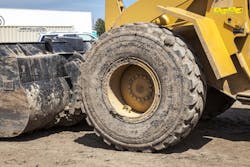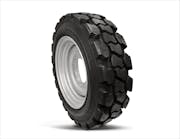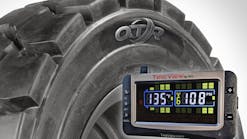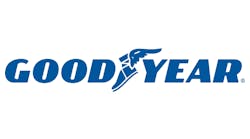Keeping Up With the Pressure to Perform
A flat tire—whether it affects an on-road hauler or pickup truck, or an off-road wheel loader or ADT—can mean costly downtime. With help from tire pressure monitoring systems (TPMS) and connectivity through telematics, maintenance managers can mitigate the risk and better control tire costs along the way.
It’s not just flats that managers need to be concerned about.
Underinflated tires increase fuel consumption and costs. According to on-road brake specialist Bendix, almost 90 percent of all tire failures result from underinflation. In the on-road arena alone, the company estimates improper inflation increases total tire-related costs by $600 to $800 annually. A 20-percent under-inflated tire means 2 percent lower fuel mileage, 30 percent shorter tire life, and 25 percent shorter tread life. The average cost of a tire failure is $800 per incident, the company says.
Correct tire pressure also prevents overheating, which is another major cause of tire damage that can lead to machine downtime.
“Tire pressure management systems allow fleets to use a single technology to drive down costs and inefficiencies across several of their largest expenses,” says Edward Lutsko, technology manager, PressurePro.
Two basic types of monitoring systems
A white paper released by the Dutch company NXP, a player in automotive tire pressure monitoring systems, neatly summarizes the two basic types of systems available:
Two kinds of tire pressure monitoring techniques are employed in vehicles—indirect and direct sensing. An indirect TPMS uses the speed sensors in the anti-lock braking system to compare wheel-rotating speeds and determine underinflated conditions. Since an under-inflated tire has a slightly smaller diameter than correctly inflated tires, it rolls at a different rate from properly inflated tires when the vehicle is in motion. The system alerts the driver when it detects an underinflation condition.
The main drawback of an indirect system is that it cannot detect the slow loss of pressure that occurs in all tires due to air permeating the rubber and tiny leaks in the sidewall bead contact or valve stem. If all the tires leak at about the same rate, there is no noticeable change between tire rotational speeds. As a result, an indirect system is not useful for the “maintenance” of tire pressure. However, it works quite well for unexpected tire pressure losses such as punctures and blowouts.
In addition to requiring the vehicle to be in motion, an indirect system generally cannot provide the resolution of a direct system. Also, the user has to reset the system every time the tires are changed, rotated, or re-inflated.
In contrast to indirect systems, direct TPMS employ pressure sensors installed in valve stems or elsewhere on the wheel rims or in the tire, to provide independent, frequent air pressure measurements for each tire. These measurements are transmitted to the vehicle instrument cluster to inform the driver.
Since Federal Motor Vehicle Safety Standard 138 allows up to a 20-minute delay for indicating 25-percent underinflation, some systems may delay the reporting of an underinflation event for several minutes. TPMS system designers use this rule to reduce data transmissions as much as possible and save battery life.
Indirect TPMS has trouble passing European and other standards, and that difficulty is reflected in a revised outlook from market research firm Strategy Analytics. Tough legislation across the globe has continued to make things challenging for indirect systems, eating into the cost advantage, says Ian Riches, director of the Automotive Electronics service at Strategy Analytics. “We currently see the market as maintaining an approximate 70/30 split in favor of direct approaches,” he says. “By 2020, we expect just over 80 percent of globally produced light vehicles to have TPMS. The global penetration of direct will be around 57 percent, and indirect 24 percent.”
With tires being a major expense for fleets, managers should look for any possible edge to control costs. To that end, here’s a look at some of the TPMS and allied technologies available from both OEM tire experts and third-party providers.
OEM tire-monitoring offerings
Tire maker Bridgestone’s B-TAG product for off-highway tires utilizes a sensor fitted on each tire. The sensors are integrated with the company’s DirectLink feature that delivers information to a manager’s computer, tablet, or smartphone.
Of particular interest is real-time temperature measurement and monitoring in running tires. The system can alert the user immediately if temperatures rise, helping to reduce tire damage and danger.
Both real-time and historical B-TAG temperature and pressure data are available in a web-based interface. Alerts are generated if tire pressure is incorrect or inflation pressure drops suddenly. B-TAG field pressure checks decrease inspection time from six minutes per wheel (manual field inspection) to less than one minute per truck, the company says.
The B-Tag sensors have been tested in extreme climatic environments (-40 F to 104 F), with or without liquid additives.
Michelin’s MEMS (Michelin Earthmover Management System) Evolution3 for mining equipment also enables tires to communicate their temperature and pressure conditions in real time and sends alerts to operators on various media, including via the Internet, email, and SMS.
Not only is data recorded in real time, but also users can monitor and analyze data for each tire throughout its lifetime via a unique ID number.
Continental Tire offers the ContiConnect digital tire-monitoring platform for remote monitoring. It allows fleet managers to see tire pressure and temperature data for the entire fleet in a single web portal every time trucks return to the fleet yard.
Its tire sensors can identify creeping air loss before it would typically be noticed in a pre- or post-trip inspection, and its platform does not depend on a telematics or over-the-road connection. Tire data is collected via sensors, which are mounted on the inner liner of the tire to prevent damage from curbing, eliminate theft, and ensure the sensor can detect the tire temperature and pressure without being influenced by heat from braking systems, Continental says.
As trucks enter the fleet yard, the yard reader station picks up data from the sensors and transmits it to the web portal via a cellular network.
Third-party providers
Trimble’s TirePulse system works by monitoring pressure and temperature through valve-stem-mounted sensors. It then communicates with telematics hardware and can report data through the Trimble/Caterpillar VisionLink interface.
In 2015, Trimble and Advantage PressurePro announced the integration of PressurePro’s TPMS capabilities with the Trimble SNM451 Connected Site Gateway telematics device. The integration, which adds full tire performance data, further expands the functionality of the SNM451.
The SNM451 is a telematics device used for tracking and managing the efficiency of site assets, light equipment, and haul vehicles in Trimble’s Web-based VisionLink fleet, asset, and site productivity management solution. Offering asset location, run time, cycle time, and load count information via cellular connection as often as once a minute, the SNM451 brings real-time information and alerts directly to customers.
With the addition of PressurePro’s Tire Management capabilities, Trimble says customers will now gain a full range of tire performance data, including real-time tire pressure and temperature readings.
Advantage PressurePro also works with telematics company Geotab for TPMS integration. Specializing in open IoT fleet management, Geotab produces advanced, web-based analytics for fleet management. It’s a company that is already well known to many fleet managers.
The integrated solutions provide users with real-time tire performance information in-cab and/or remotely, giving drivers the ability to correct issues as they arise and managers the ability to monitor every tire in a fleet from a single location.
“PressurePro simplifies and streamlines tire maintenance, arming users with a powerful tool that identifies tire performance trends, taking their tire maintenance programs from reactive to proactive,” Lutsko says.
“Commercial fleets operate in some of the most diverse and competitive landscapes, requiring them to remain progressive in lowering their cost of operations all while becoming more efficient,” says Vanessa Hargrave, PressurePro’s COO and CMO. “PressurePro provides fleet owners and managers the raw data needed to save fuel, cut downtime, extend tire life, and more, as well as a fully backed platform that automatically computes and breaks down the tire performance data into easily understood dashboard metrics.”
The integrated solutions, which utilize PressurePro’s LINK (Gateway) and PULSE solutions, allow users to connect and communicate through the vehicle network or utilizing the IOX-CAN cable from Geotab, allowing streamlined data flow to the Geotab GO6, GO7, and Go Rugged products. (Legacy GO4 solutions are also supported.)
Valor’s TPMS monitors tires in real time, and its “liquid-friendly” magnetic-mount sensors measure air pressure and temperature within tires every four seconds, sending the values wirelessly to the cab display directly or via the transceiver every 30 seconds.
Valor provides for multiple methods for a company to retrieve and manage tire data, from providing its own software solutions to plugging into third-party telematics systems.
Other features include five to seven years of battery life, and immediate warnings for high/low pressure, air leakage, and high temperature.
The Valor TPMS system uses four components (antenna, display, sensor, and transceiver) to create one complete solution. The internally mounted sensor monitors both the tire’s temperature and pressure from the inside out.
The antenna receives data wirelessly from the sensors and then transmits into the transceiver, and the display visualizes tire pressure and temperature data in real time. Display contents vary depending on the solution chosen.
The “liquid-friendly” magnetic-mount sensor has been engineered from the chip-up to withstand the demanding environments both inside and outside tires, the company says. It also monitors tires that use liquids.
The display unit can save a certain amount of history data to be downloaded to the company’s hand-held SmarTool. The display unit has an RS232 plug to transfer data to the SmarTool. The hand-held unit has a 2G SD card to store data.
When a truck comes back to the yard, all historic data for tire pressure and temperature that was saved in the display unit will automatically download wirelessly onto the user’s fleet-management computer for management to review.
The system is designed to integrate with Geotab’s web-based fleet-management software. With data transmitted wirelessly through Geotab GO devices, managers can monitor tire health in real time from the “MyGeotab” fleet-management interface.
The Bendix CVS SmarTire system shows tire pressure and temperature status on a dash display. In the yard, technicians can check the same information on a hand-held reader. It works using wheel-mounted sensors in on-road truck tires, plus a wireless receiver to read and send both tire pressure and temperature information to an in-cab dash display. The system will alert the driver when the tire pressure becomes too low, or the temperature becomes too high.
For trailer pulling, wheel-mounted sensors in the tires, along with another wireless receiver on the trailer, read what’s happening and provide a lighted indication on a trailer-mounted lamp that the driver can check in the side mirror.
A step further: tire-tracking systems
Monitors may or may not be married to tire-tracking systems to further help managers.
To use tire-tracking systems, managers must typically pay tire dealers to check and set pressures, measure tread depth, and inspect for unusual wear or outright damage. The data is collected for an online database and then, at a minimum, is used to alert the fleet owner to abnormalities, as well as to generate reports.
The systems can help a fleet track costs and manage inventory.
“OTR tire management systems can help construction firms monitor the performance of their tires, identify maintenance opportunities, reduce expensive downtime, forecast future tire needs more accurately, and ultimately lower their operating costs while optimizing their equipment performance,” says Eric Matson, manager, global field engineering, OTR, for Goodyear.
Four examples of tire-tracking systems are Goodyear EMTrack, Michelin Tire Care, Bridgestone TreadStat, and Yokohama YTrack.
These types of programs, which are constantly being enhanced by tire manufacturers, can be relatively basic, or as data-rich as desired, to provide assistance in tire maintenance management and cost control.








